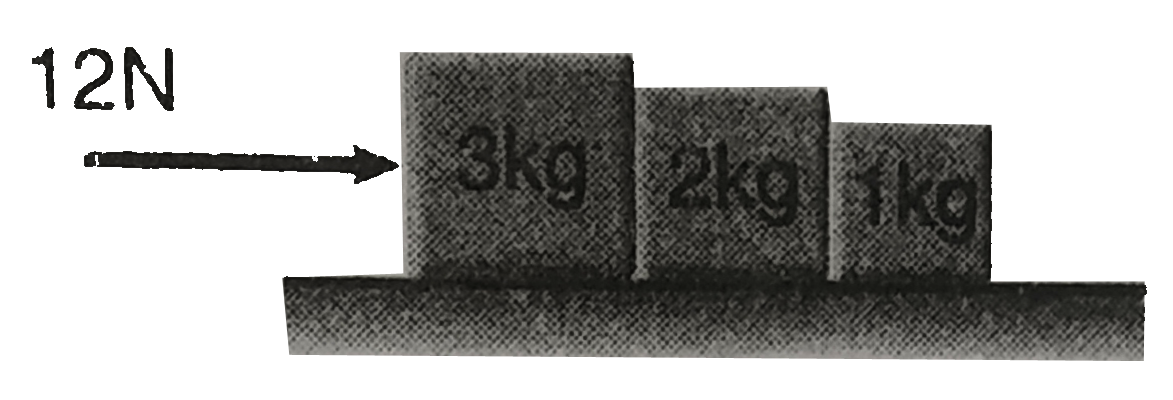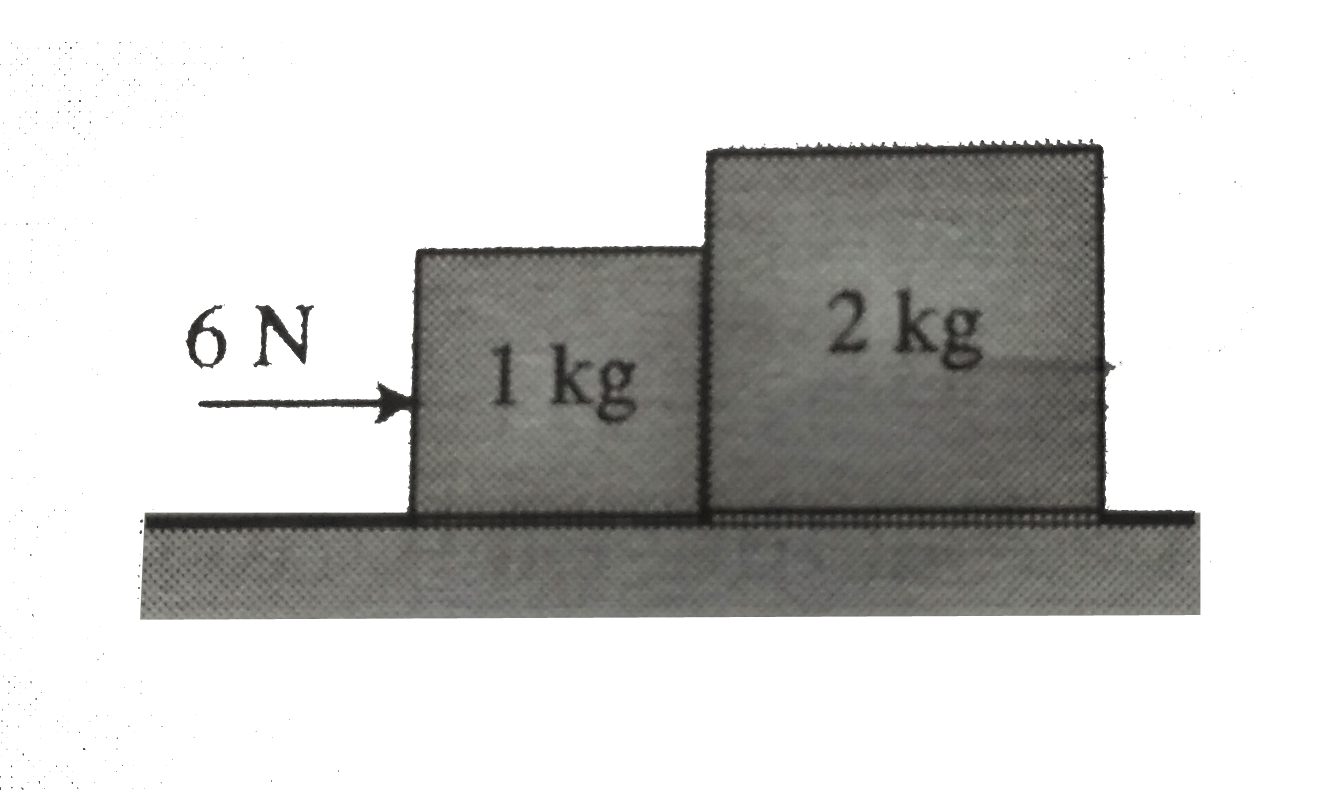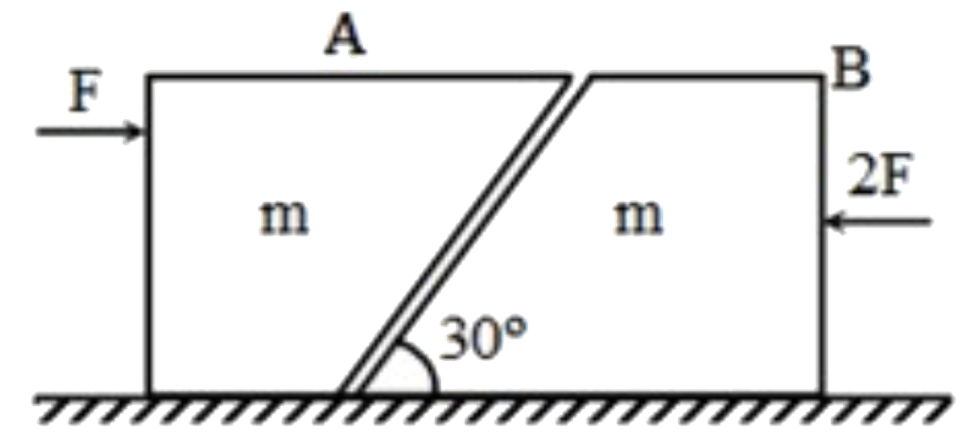Two block of masses m1andm2 are placed side by side on a smooth horizontal surface as shown in fig. A horizontal force F is applied on the block .

(a) Find the acceleration of each block.
(b) Find the normal reaction between the two blocks.
Method 1: Since the two blocks always remain in contact with each other, they msut move with the same acceleration.

Using Newton's second law, we get
For block m1:F−N=m1a
For block m2:N=m2a
On adding the two equations, we get
f=(m1+m2)a⇒a=Fm1+m2
Substituting the value of a in (ii), we get
N=m2a=Fm2m1+m2
Method 2 : The situation may be considered as follows : Instead of drawing the free-body diagrams of each block, we can draw the free-body diagram of both blocks together as shown in fig

The net force acting on the system is F, and the total mass of the system is m1+m2. Thus, a=Fm1+m2
To find out the normal reaction N between the two blocks, we can imagine the following: Block m2 is moving with an acceleration a, therefore, the net force acting on it most be m2a which is nothing but the normal reaction applied by the block m1. Thus
N=m2a=m2Fm1+m2 .
Topper's Solved these Questions
- NEWTON'S LAWS OF MOTION 1Book:CENGAGE PHYSICSChapter:NEWTON'S LAWS OF MOTION 1Exercise:Solved Examples
Explore 11 Videos
- NEWTON'S LAWS OF MOTION 1Book:CENGAGE PHYSICSChapter:NEWTON'S LAWS OF MOTION 1Exercise:Exercise 6.1
Explore 11 Videos
- MISCELLANEOUS VOLUME 2Book:CENGAGE PHYSICSChapter:MISCELLANEOUS VOLUME 2Exercise:INTEGER_TYPE
Explore 10 Videos
- NEWTON'S LAWS OF MOTION 2Book:CENGAGE PHYSICSChapter:NEWTON'S LAWS OF MOTION 2Exercise:Integer type
Explore 1 Video
Similar Questions
Two blocks of masses 4kg and 2kg are placed side on a smooth horizontal surface as shown in the figure. A horizontal force of 20N is applied on 4kgblock. Find
(a) the acceleration of each block.
(b) the normal reaction between two blocks.

View SolutionThree blocks of masses 3kg,2kg and 1kg are placed side by side on a smooth surface as shown in figure. A horizontal force of 12N is applied on 3kg block. Find the net force on 2kg block.

View Solution
Knowledge Check
Two blocks of masses 1 kg and 2 kg are placed in contact on a smooth horizontal surface as shown in fig. A horizontal force of 6N is applied on a 1-kg block. Find the force of interaction of the blocks.

A4NB5NC10NDnoneTwo blocks of equal mass 2 kg are placed on a rough horizontally surfaces as shown and a force F is applied on the upper block . The system is initially at rest . Find acceleration of the lower block in m/s2 .
 A3m/s2B5m/s2CZeroDnone of these
A3m/s2B5m/s2CZeroDnone of theseTwo blocks of mass m1andm2 area placed side by side ona smoth horizontal surface .Two horozontal forces F1andf2 act on m1andm2respectvely .If N is the normal contact force between the block then
 AN=0whenF1m1=F2m2BN=0whenF1m1<F2m2CN≠0whenF1m1=F2m2DN≠0whenF1m1>F2m2
AN=0whenF1m1=F2m2BN=0whenF1m1<F2m2CN≠0whenF1m1=F2m2DN≠0whenF1m1>F2m2
Two blocks 'A' and 'B' each of mass 'm' are placed on a smooth horizontal surface . Two horizontal force F and 2F are applied on the blocks A and B , respectively , as shown in figure . The block A does not slide on block B . The normal reaction acting between the two blocks is

View SolutionTwo blocks of mass m1andm2 lie on smooth horizontal table in contact with each other as shown in figure

If a force F is applied to the mass m1 then the contact force between the block will be
View SolutionA block of mass M is pulled along a horizontal frictionless surface by a rope of mass m as shown in A horizontal force F is applied to one end of the rope. Find
(a) the acceleration of the rope and block
(b) the force that the rope exerts on the block
(c) the tension in the rope at its mid point

View SolutionTwo blocks of mass m and 2m are arranged on a wedge that is fixedd on a horizontal surface. Friction coefficient between the block and wedge are shown . Find the magnitude of acceleration of two blocks.

View SolutionTwo blocks A and B each of mass m are placed on a smooth horizontal surface. Two horizontal force F and 2F are applied on blocks A and B, respectively, as shown in fig. Block A does not slide on block B. Then then the normal reaction acting between the two blocks is (assume no friction between the blocks)

View Solution

